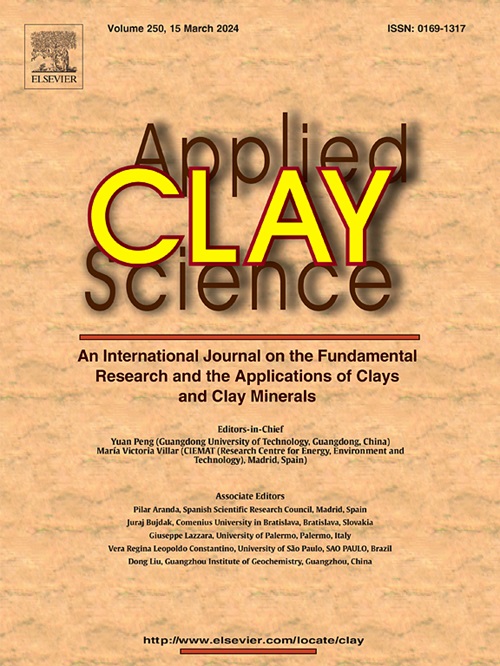Montmorillonite revolution: a unified exploration of exfoliation techniques and its emerging role as an advanced drug delivery carrier
IF 5.3
2区 地球科学
Q2 CHEMISTRY, PHYSICAL
引用次数: 0
Abstract
The continual quest for efficient drug delivery systems has led to the exploration of advanced clay-based nanocarriers. In this regard, montmorillonite (MMT) emerging as a highly promising candidate. MMT's layered structure and high surface area, coupled with its natural ability to exfoliate, make it an excellent candidate for drug delivery applications. Exfoliation, the process of separating MMT layers into nanoscale sheet-like layers, displays a critical feature in upgrading its properties by enhancing the available surface area and improving interaction with drug molecules, and directly impacting drug loading capacity and entrapment efficiency through reducing its aggregation, which is its natural tendency. Researchers have extensively explored exfoliation techniques to harness these benefits, leading to the development of MMT-based nanosheets that provide a higher surface area-to-volume ratio, therefore, MMT possibly suitable for drug delivery and controlled release. Additionally, the safety and toxicity profiles of MMT have been rigorously evaluated, confirming its excellent biocompatibility. This review highlights the advancements in exfoliation techniques, their role in optimizing MMT as a nanocarrier, and its relevance in modern drug delivery systems.

蒙脱石革命:剥离技术的统一探索及其作为先进药物输送载体的新兴作用
对高效药物输送系统的不断追求导致了先进的粘土基纳米载体的探索。在这方面,蒙脱土(MMT)是一个非常有前途的候选材料。MMT的分层结构和高表面积,再加上其天然的去角质能力,使其成为药物输送应用的绝佳候选者。剥离是将MMT层分离成纳米级片状层的过程,其关键特征是通过增加有效表面积和改善与药物分子的相互作用来提高其性能,并通过减少其聚集直接影响药物的负载能力和包裹效率,这是其自然趋势。研究人员已经广泛探索剥离技术来利用这些优势,从而开发出基于MMT的纳米片,提供更高的表面积与体积比,因此,MMT可能适用于药物输送和控释。此外,MMT的安全性和毒性已经过严格评估,证实其具有良好的生物相容性。这篇综述强调了剥脱技术的进展,它们在优化MMT作为纳米载体中的作用,以及它在现代药物输送系统中的相关性。
本文章由计算机程序翻译,如有差异,请以英文原文为准。
求助全文
约1分钟内获得全文
求助全文
来源期刊

Applied Clay Science
地学-矿物学
CiteScore
10.30
自引率
10.70%
发文量
289
审稿时长
39 days
期刊介绍:
Applied Clay Science aims to be an international journal attracting high quality scientific papers on clays and clay minerals, including research papers, reviews, and technical notes. The journal covers typical subjects of Fundamental and Applied Clay Science such as:
• Synthesis and purification
• Structural, crystallographic and mineralogical properties of clays and clay minerals
• Thermal properties of clays and clay minerals
• Physico-chemical properties including i) surface and interface properties; ii) thermodynamic properties; iii) mechanical properties
• Interaction with water, with polar and apolar molecules
• Colloidal properties and rheology
• Adsorption, Intercalation, Ionic exchange
• Genesis and deposits of clay minerals
• Geology and geochemistry of clays
• Modification of clays and clay minerals properties by thermal and physical treatments
• Modification by chemical treatments with organic and inorganic molecules(organoclays, pillared clays)
• Modification by biological microorganisms. etc...
 求助内容:
求助内容: 应助结果提醒方式:
应助结果提醒方式:


